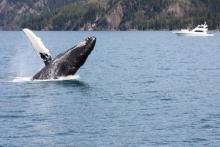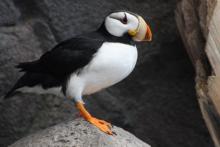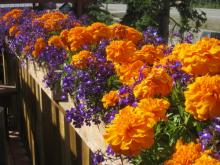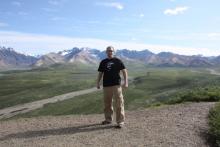What Are They Doing?
Underlying the northern arctic coast of Alaska is a thick layer of permafrost. As water melts and pools on top of the permafrost, thaw lakes are formed. There are many thaw lakes on the North Slope of Alaska. As they decompose organic material, the bacteria and other microorganisms living in thaw lakes produce methane. Methane is a greenhouse gas, and increased microbial activity in thawing permafrost areas could lead to changes in the atmosphere due to the release of methane.
Microbial activity in thaw lakes is not very well understood. This research was important for better understanding how microbial activities affect the biogeochemical cycle, or the way specific chemicals move through living and non-living processes on Earth.
To collect their data, the research team combined research methods from biology, ecology, and biotechnology. They collected data in the field including soil cores, thaw depth, water table depth, and dissolved oxygen measurements. Additionally, they monitored bacterial respiration and conducted related lab experiments.
Where Are They?
The team worked at five different field sites which are part of the Barrow Environmental Observatory (BEO). The Observatory is located near the Barrow Arctic Science Consortium (BASC) where the team lived and conducted lab work. BASC is just outside the community of Barrow, Alaska. Barrow is located on Alaska’s North Slope near the shoreline of the Arctic Ocean. Barrow is a small community of approximately 4,500 people. The climate is arctic, with the daily minimum temperature dropping below freezing 300 days a year. The community is primarily inhabited by Inupiat Eskimos, and it is only accessible by airplane.
Latest Journals
Lars Angenent is an Associate Professor in the Department of Biological and Environmental Engineering at Cornell University. His research interests include the conversion of organic waste into bioenergy, the development of biosensors, photobioreactors and bioaerosols, and the creation of biocomputing devices that are based on microbial electrochemical technologies. Learn more about Dr. Angenent's research at his faculty webpage [http://angenent.bee.cornell.edu/DrLarsAngenent.html]

Elliot Friedman is a PhD candidate in Dr. Angenent's Lab at Cornell University. His research focuses on engineering applications of microbial electrochemical technologies. He designed and constructed the biosensors being used in the Arctic.

David Lipson is an Associate Professor in the Department of Biology at San Diego State University. His research interests include soil microbial ecology, plant-microbe interactions, and linking microbial diversity to ecosystem processes.

Ted Raab is a Senior Investigator in the Carnegie Institute of Science at Stanford University. His research interests include plant physiological ecology, analytical chemistry and spectroscopy, synchrotron-based imaging, and cryosols.





